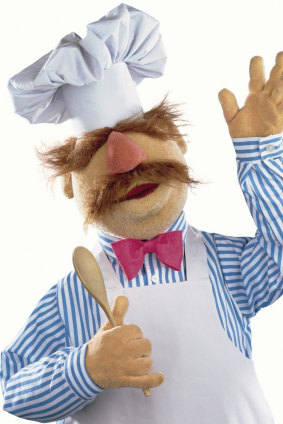By David Astle
How much milk do you like in your tea? Should I add a dash, a splash, or maybe a splosh? Better than a glug, I guess, or perhaps you’d prefer a drizzle? On second thoughts, here’s the carton: do it yourself.

The Swedish Chef knows: we need to preserve the guesstimates.
Guessing feels risky when it comes to quantities, yet many recipes and cocktail guides peddle such approximates. Add a dollop of mayo. Sprinkle a pinch of cinnamon. Smear a smidge of wasabi. Having a feel for baking is one thing, yet if your skerrick is more a slather, your cake may prove a disaster.
Folklore researcher Claire Cock-Starkey exposed the charms of rough volumes in a recent piece for Lapham’s Quarterly. “When recipes first began to be written down, they were recorded in the vernacular rather than with a rigid list of exact measurements.” Just as ovens, before temperature gauges intervened, were hot or warm or slow. More studio than lab, the historic kitchen doled dashes of oil, two splashes of pastel.
Publishing changed things, plus the metric system, where cups and spoons came with milligram tallies. Though for Jacqui Newling, that’s not necessarily a win. As author of Eat Your History: Stories and Recipes from Australian Kitchens (UNSW Press, 2015), Jacqui is all for inexactitude.
“It makes it fun to explore. You have to be open to failure. There’s a lot of experimentation where you need to go by instinct. If you’re making a dough, say, and you’ve used a standard cup instead of an old-fashioned cup, you have to say no, this is never going to be a dough, I need to add more. It’s about feel.”
Texture too, as Jacqui noted on ABC Radio last week, chatting about dollops and dashes. “Say the word dollop, and you feel it fall from your mouth in a lump or a clump. So if you add a dollop of cream, it’s something you have to lift and drop off the spoon. It has far more emotion than an ounce.”
By far more, I wondered, did Jacqui mean twice as much emotion or ten times more? Who knows, and who cares? Since we don’t expect precision in idiom, why demand the equivalent in a cook’s self-expression? By virtue of its sound, and short-o sturdiness, dollop conjures a plump scoop of something viscous, a glob of aioli, a blob of custard. Nothing more, nothing less.
Just as dash implies a liquid shot, the spritz equivalent of sprint, a speedy baptism of vanilla essence or angostura. Meanwhile, smidgen has a smearable quality, like a Vegemite smudge, more dab than daub, a hint of paste swiped upon the pasta. Isn’t that enough?
To hell with culinary websites suggesting that a smidgen equates to one-thirty-second of a teaspoon, apparently greater than a smidge, which weighs in at one-forty-eighth, or roughly two-and-a-half milligrams. Dash, there goes the romance.
Data rules our lives. Numbers and percentages, deficits and ratios. The cookies of the kitchen – with their smatter of chocolate chips – have been usurped by the cyber-cookies of browser histories. Every reason to preserve the guesstimates, the hunch of pinches, the whole vibe of volume. We need more poetry at our fingertips.
Last week, as part of the radio chat, I posed a vox-pop question: How many smidgens are in a dollop? Responses varied from six to 100, to “more than a few”. Others wished to clarify whether we’re talking a generous or a modest dollop. One or the other, you choose. Because your passionfruit sponge is like none I’ve ever tasted, I swear. It’s divine. What’s your secret?
To read more from Spectrum, visit our page here.
The Morning Edition newsletter is our guide to the day’s most important and interesting stories, analysis and insights. Sign up here.